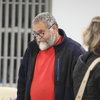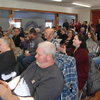Life of World War II soldier depicted in recently discovered journal
WESTERLO — Clyde Filkins was a well-known figure in the town of Westerlo as its longtime rural mail carrier. He was also a veteran of World War II and a prisoner of war, but not much was known about his war years until recently.
“Last month, I received some of the best documentation ever as a historian,” Westerlo town historian Dennis Fancher recounted at a town board meeting in April.
After Filkins’s wife died this past winter, Fancher was contacted by two of their relatives, who asked him if he was interested in any items from World War II.
“I said, ‘Absolutely!’” Fancher recounted.
He told The Enterprise last week that Filkins’s nephew Dennis LeBuis sent him copies made of documents from Filkins’s time overseas, including telegrams, discharge papers, and a small address book used as a journal.
Fancher said that Filkins’s family also donated two of his Army trench coats to the Westerlo Reformed Church. The minister there called Fancher and his wife, Sue, to see if they would like to take them.
Filkins’s coat, now on display in the town museum, is in near-perfect condition, with his rank insignia sewn onto the shoulder and plastic buttons, which replaced brass buttons for World War II; the button insignia was also changed from the branch of service to what was known as a G.I. (for government issue) insignia of the Army eagle.
Filkins grew up in Berne but eventually moved to Westerlo and became the town’s mail carrier. His wife, Peg, kept the old post office sign in their cellar, remarked the museum’s director, Mary Jane Araldi; it is now displayed in the town museum.
But before all that, Filkins was inducted into the United States Army in February 1943. He left New York for Scotland, and then England, that October. Sometime along the way, he must have picked up an address book, labeled “Souvenir of Durham, N.C.”; at the front of the book he listed the places he traveled to and when.
In December, Filkins arrived in France and then went to Germany where he fought in his first battle, the Battle of the Bulge, the last major German offensive campaign on the Western Front. He was captured on Dec. 19, 1944, three days into a battle that raged until Jan. 25, 1945, the largest and bloodiest battle fought by Americans during the war.
It was German troops that forced Filkins and other prisoners to march 40 miles to a “Stalag,” a prisoner-of-war camp. He was then put in a boxcar and taken to another camp where he was assigned a POW number. Another boxcar took him to a camp at Gorlitz, on the western border of Germany.
While in the camp, Filkins had to eat grass soup out of a tin that also was used as a urinal, said Fancher. The Allies bombed the town in order to attack the Germans. Filkins remarked in his journal how much he craved a good meal or tobacco. He tried to escape twice but was captured. In March of 1945, he successfully escaped and began a long trek across Germany.
While Filkins was captured, his mother, Nettie, was sent several telegrams and letters informing her of what happened. In April, Major General J.A. Ulio wrote to her that he had no news, good or bad.
“It has been my fervent hope that favorable information would be forthcoming so that you might be relieved from the great anxiety from which you have borne during these months,” he wrote.
But Ulio did not yet know that Filkins was already free.
Much of Filkins’s writing was a matter-of-fact account of his life in the camp and then traveling. His last entry in his journal on April 12, however, showed his elation.
“Liberated near Rhode so happy I cried … ,” he wrote. “We traveled over 1000 miles from 2/14-4/12 on foot. Sure saw a lot of Germany the HARD WAY,” he ended in all capital letters.
Nearly 40 years later, on Nov. 30, 1984, Filkins was awarded the Bronze Star for ground combat. He had a license plate with a POW label and was an active member of the American Ex-P.O.W Association, but he otherwise spoke very little about his time during the war.
When he died in 2007, his niece and nephew — Donald LeBuis and Marlene Boomhower — both remarked on his silence to The Enterprise. LeBuis said there was only one time his uncle told him about the war, sharing details he hadn’t even told his wife.
“He was one of the ones who came home and was ready to get on with his life,” Boomhower said soon after her uncle died. “He did not talk about his experiences and we all respected that,” she said.



